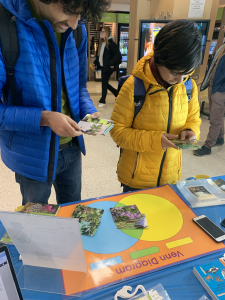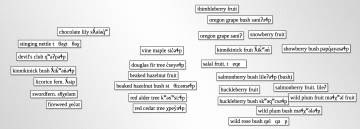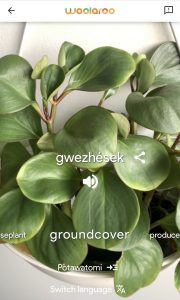Engaging in species identification and classification is a common and, many would argue, necessary aspect of science education. There are many tools, digital and analogue to assist us as we explore and learn about the world around us. In a recent collaboration with the Education Library, we showcased a few resources and approaches to support engaging students in plant and animal identification. As we shared with attendees at the 2023 TEC Expo in Neville Scarfe at UBC, we engaged folks in conversation about some considerations with ‘naming’… Applying a name has long been a colonial and, in the main, patriarchal activity when the local Indigenous language is ignored. Further, appropriation through naming and through not acknowledging cultural knowledge and Indigenous science is problematic, to say the least.

Sorting using Northwest ID cards.
Our goal today was to not only share some resources and strategies that might support learning in the classroom, but to spark conversation about more decolonized practices. As a settler, born on the coast, with a strong interest in and appreciation for native flora, fauna and other ‘things’/inanimate beings, one small way I am attempting to respond to the Truth and Reconciliation Commission Calls to Action is to begin to learn and share their names in hən̓q̓əmin̓əm̓ (where I currently work) and Halq’eméylem (the dialect of the lands on which I was born and lived as a child). By learning the names these plants and animals have long been known, I am also seeking to learn more about local ecosystems and connections between all of the beings (including those we may not, in western ways, recognize as living).
The following resources are helpful to teachers looking to incorporate Indigenous Science/Traditional Knowledge:
- Knowing Home, Braiding Indigenous and Western Science is an open educational text created by Gloria Snively and Wanosts’a7 Lorna Williams and shared by the Victoria School District’s Indigenous Education team.
- Visit the Ministry of Education Indigenous Ed resource page, to find videos and a Resource Inventory to help teachers incorporate First Peoples Knowledge and Perspectives. Of particular interest at the bottom of the page is the Framework for Designing Indigenous Science Resources (a rubric to help create and evaluate resources that includes: Indigenous voice, language, diversity, protocols, relationship to the land, ways of learning and teaching.)
- FNESC has a comprehensive PDF to assist grades 5 to 9 teachers looking to incorporate Indigenous Science in their classes. There is also a version for Secondary educators linked on the same page.
One further note about identification and naming is that, as a naturalist educator for many years, I have found that applying a name to something too soon can cause the learning to stop. My preference is to have students observe, describe, discuss and questions BEFORE we engage in identification.
Some tools/resources to support your learning
Books
The Education library has consolidated a few resources to support this exploration of place and language that can be found of the ‘TecExpo post’ on their website. It includes a wonderful field guide “Luschims Plants” (I have it in my collection and donated one I purchased from Strong Nations to the library), the lyrical and informative “Braiding Sweetgrass” and more! The post links to the library catalogue and also to some well-curated and current collections via the Education Library Booklists (Integrating First Peoples’ Perspectives and Principles of Learning, Connections to Land, Biodiversity and Biomes, Seeds and Gardening).Several of these lists were compiled in collaboration with the Xwi7xwa Library. A valuable place on campus to visit as we learn and unlearn.
Cards
Card sorting is a cooperative learning technique that allows learners to make connections between ideas in a kinesthetic way. This embodied learning activity (learning with and through movement) can also provide a model for an excellent study strategy.
The Education library has several sets of sorting cards including Salmon Life Cycle, Seasons, Pacific Northwest plant knowledge cards (featuring Indigenous languages, including Lekwungen, SENĆOTEN, Hul’qumi’num, and Diitiid) and two sets by my friend Gloria Snively who created “Ocean Snimal Clue” cards about the Pacific Coast Ecosystem and Pacific Coast Information Cards (geared to intermediate/high school/adults).
What can we do with Cards?
- Card sorting in partners or groups adds a ‘socio-constructivist’ element where your students are making sense of concepts and content with one another. It allows them to engage with one another AND with the curriculum. Ask students to narrate/talk out loud while sorting. In a class of more senior students, one student in a group might be taking notes on the reasoning and discussion behind the sort. This could help students self-evaluate core competencies including communication and critical thinking.
There are two general types of sorts
- Open Card Sort: organize topics into groups that make sense to them and then name each group they created in a way that they feel accurately describes the content. Use an open card sort to learn how your students group content and the terms or labels they give each category. We might also call this ‘open sorting and classifying’
- Closed Card Sort: sort topics into pre-defined categories. A closed card sort works best when you are working with a pre-defined set of categories, and you want to learn how your students sort content items into each category.
Some approaches to sorting
- Think of different ways card sorting might be introduced in your context.
- A simple set of instructions, include a printable and a video showing students engaged in sorting can be found on the blog ‘Teacher Toolkit’
- Graphic organizers (links to external site) such as Venn diagrams can be used to help students organize their sorts. Once introduced to concept mapping, students might sort and connect ideas as a concept map! Cards might even be organized in a linear way (think: timelines or sequencing)
Web-based Resources
- First Voices is an online space where Indigenous communities share and promote language, oral culture and linguistic history. A unique thing about this space is that communities can decide if they prefer to share with the wider public or only within their communities. Additional resources including a language and culture map of BC, are linked on this blog post (in the Scarfe Sandbox) titled: Resources for Indigenizing and Decolonizing Education
- LiveIt Earth is a set of online high quality/high interest multimedia resources that includes some local Indigenous content created in partnership with communities. UBC Teacher Candidates and Education students are offered free one year access to this resource.
- Using the Museum of Vancouver’s Indigenous Plant Guide, you can hear and learn the Squamish and hən̓q̓əmin̓əm̓ words for a variety of plants that are native to BC.
- Flippity.net: allows the user to make their own manipulatives using various browser based applets.

Example of a three 3 way (Venn diagram style) sort showing fruiting/berries and non-fruiting/no berries.
For our session, I utilized the information from the Museum of Vancouver’s website to create a digital card sort using an open applet “Flippity.net” by making cards that showed both the English name and the hən̓q̓əmin̓əm̓ name. Flippity.net is accessible as an applet (where you can customize cards) and/or as a google form you can copy and modify to a greater extent. In my example, while participants weren’t able to read/decode the hən̓q̓əmin̓əm̓ name, the cards did highlight that there ARE names in traditional languages that need to be recognized, seen and, hopefully at some point, learned. In speaking with one of our language and literacy professors, I’ll be doing some research into API learning tools
- Woolaroo
is an interesting example of a multilingual cloud-based application meant for handheld devices that allows the user to scan an object, plant, animal and then read or hear the name or description – in cases where no specific name or word exists for something – in the language selected.
- Woolaroo
Mobile Apps
The use of digital technologies in outdoor or place-based learning requires careful consideration. Benefits may include the opportunity to for authentic, real-world opportunities for developing digital literacies, to engage in citizen science and to enable students increased agency or choice of learning mode and medium for gathering information, data or for expression Considerations include (but aren’t limited to), issues of ‘over-mediating’ the natural world, potential distraction, equity and access, privacy and permissions. Teachers should always ask themselves about their purposes: when and how might we use these tools? who might need them? who might benefit? when to not use them?
A few Apps to try
- iNaturalist: a citizen science app to support crowd sourcing ID in the field. An amazing bi-product of this application is the development of a large database of images available for research. Engage in citizen science as you explore the environment and ‘log’ your observations.
- Seek by iNaturalist with your students to support ID – fairly simple interface: the Seek camera will draw from observations posted by members of the iNaturalist community to try to ID the photo. You can even scan the environment for common species of plant, birds, amphibians, insects!
- LeafSnap is a free app created by the Canadian Wildlife Federation that allows you to learn to ID trees by their leaves, flowers and seeds.
- Plantsnap was developed as a collaboration with several non-profits along with SnapChat that helps you ID plants by taking a photo and getting instant feedback. Their goal is to map out the world’s plants.
- iPhone and iPad users can use the Visual Look Up feature to use Siri’s AI to identify plants, insects, landmarks, and more in pictures they have taken. You’ll need to update your device to the latest iOS. To start, open a picture on your camera, press the Visual Look Up button (‘i’ in a circle with stars on the left), then press Look Up and it will offer ideas based on a web comparison of images.
Post Author: Yvonne Dawydiak, Learning Design Manager, Teacher Education (Oct. 2023)
I would like to acknowledge that my attempts may not be perfect and there may be questions about my approach or about resources. Please be in touch if you have suggestions or questions.


